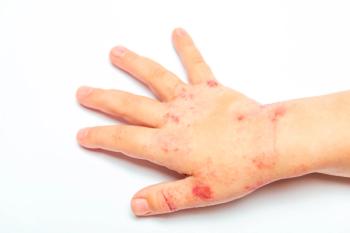
A New Trend in Homemade Tattoos
A 13-year-old boy from inner city Philadelphia presented with an infected “tattoo” on his right forearm. On examination, he had multiple hypopigmented scars on his extremities. When asked about the scars, the patient appeared embarrassed and stated that they were tattoos, which he created with an eraser from a pencil.
A 13-year-old boy from inner city Philadelphia presented with an infected “tattoo” on his right forearm. On examination, he had multiple hypopigmented scars on his extremities. When asked about the scars, the patient appeared embarrassed and stated that they were tattoos, which he created with an eraser from a pencil. To make a tattoo, he rubbed the eraser across the skin while applying strong pressure for an extended time. The friction would eventually abrade the skin until it became red and bled. The wound would scab, leaving a permanent hypopigmented scar. This patient’s wound was erythematous, indurated, warm, and tender on examination (He refused to have his wound or scars photographed). He was treated with antibiotics and local wound care. The infection resolved, leaving a hypopigmented scar.
Seeing teenagers with tattoos is not unusual in a dermatology practice. Up to 30% of Americans under age 30 have tattoos. In Canada, 8% of high school students have at least 1 tattoo.1 The types of tattoos available range from temporary (eg, henna) to permanent (eg, professionally inked). Homemade eraser tattoos-hypopigmented scars in various shapes or letters on the arms and legs-appear to be a phenomenon among elementary and middle school students in the United States. These tattoos are easily accessible, require no parental consent, and have no cost barrier. The motivation for teenagers to apply these tattoos may be artistic expression, peer pressure, or the need to be accepted. Some teens report that their tattoos were applied against their will by another student.
Homemade tattoos are often incidental findings on examination. Teens with infected tattoos often self treat and do not inform their parents of their condition. Homemade tattoos that break the epithelial barrier are susceptible to infection similar to ink tattoos.2 A concern with eraser tattoos is the the risk of toxicity from dermal absorption of phthalates in the eraser.3 Dermal absorption of phthalates from common cosmetics has been documented, although the levels in these commercial products are small.4 The extent of cutaneous absorption of phthalates from erasers is unknown.
It is important to note the presence of tattoos in adolescents during regular office visits and, if found, discuss their significance. Tattoos can signal a troubled teen. Adolescents who use painful methods to permanently scar themselves may be at risk for other adverse behaviors, such as eating disorders, drug use, and violence.5 The type of tattoo and the design can also be useful. The design of the tattoo may reveal a gang name or slogan. Gang-related tattoos often symbolize membership or the gang’s beliefs; however, they may represent an act of violence. For instance, a tattoo in the shape of a teardrop may indicate murder.
An eraser tattoo is often seen in younger teens (under age 15) who are unable to obtain a permanent ink tattoo. Tattoo regulations vary by state; however, most states prohibit tattooing of minors (those younger than 18 years). A few states allow tattooing of minors with parental consent. As stated above, eraser tattoos may be a sign of peer pressure or forced violence imposed by another teen. Tattooing someone against his will is more than just a form of bullying; it is assault.6
Most cases of homemade tattoos tend to be a form of self-expression for peer acceptance rather than a form of self-mutilation. Teens with homemade tattoos warrant a social and/or psychological assessment to rule out abuse or a psychological disorder. If after this assessment a teen is suspected of risky behavior, he or she can be counseled or referred to social services. If the tattoo is merely a form of self-expression, the clinician can discuss other ways patients can express themselves that do not pose a medical risk of inflammation, infection, or scarring.
References:
REFERENCES:
1.
Jafari S, Copes R, Baharlou S, et al. Tattooing and the risk of transmission of hepatitis C: a systematic review and meta-analysis.
Int J Infect Dis.
2010 Jul 31. [Epub ahead of print].
2.
Drage LA, Ecker PM, Orenstein R, et al, An outbreak of Mycobacterium chelonae infections in tattoos.
J Am Acad Dermatol.
2010;63:501-506.
3.
Scientific Committee on Health and Environmental Risks. Opinion on phthalates in school supplies. October 17, 2008.
http://ec.europa.eu/health/ph_risk/committees/04_scher/docs/scher_o_106.pdf
. Accessed October 26, 2010.
4.
Koo HJ, Lee BM. Estimated exposure of phthaiates in cosmetics and risk assessment.
J Toxicol Environ Health A.
2004;67:1901-1914.
5.
Carroll S, Riffenburgh RH, Roberts TA, Myhre EB. Tattoos and body piercings as indicators of adolescent risk-taking behaviors.
Pediatrics.
2002;109:1021-1027.
6.
Strauss V. Forcibly tattooing a boy isn’t bullying. It’s assault. The Washington Post. May 21, 2010.
http://voices.washingtonpost.com/answer-sheet/bullying/forcibly-tattooing-a-boy-isnt.html
. Accessed October 28, 2010.
Newsletter
Access practical, evidence-based guidance to support better care for our youngest patients. Join our email list for the latest clinical updates.








